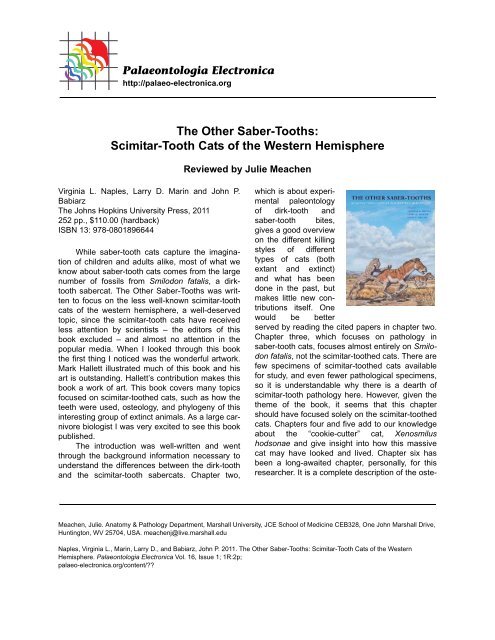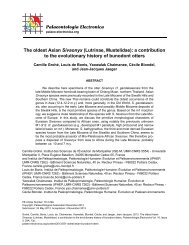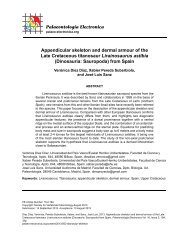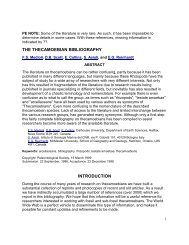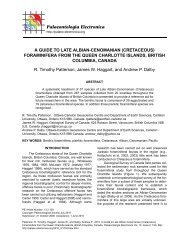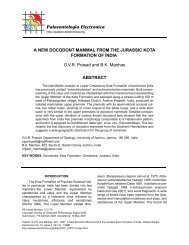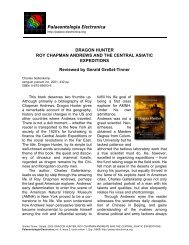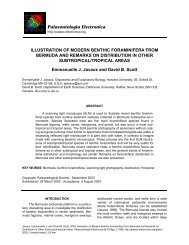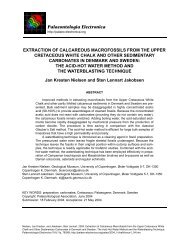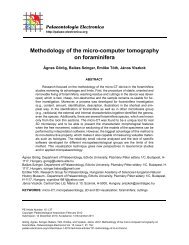PDF version - Palaeontologia Electronica
PDF version - Palaeontologia Electronica
PDF version - Palaeontologia Electronica
Create successful ePaper yourself
Turn your PDF publications into a flip-book with our unique Google optimized e-Paper software.
<strong>Palaeontologia</strong> <strong>Electronica</strong><br />
http://palaeo-electronica.org<br />
The Other Saber-Tooths:<br />
Scimitar-Tooth Cats of the Western Hemisphere<br />
Reviewed by Julie Meachen<br />
Virginia L. Naples, Larry D. Marin and John P.<br />
Babiarz<br />
The Johns Hopkins University Press, 2011<br />
252 pp., $110.00 (hardback)<br />
ISBN 13: 978-0801896644<br />
While saber-tooth cats capture the imagination<br />
of children and adults alike, most of what we<br />
know about saber-tooth cats comes from the large<br />
number of fossils from Smilodon fatalis, a dirktooth<br />
sabercat. The Other Saber-Tooths was written<br />
to focus on the less well-known scimitar-tooth<br />
cats of the western hemisphere, a well-deserved<br />
topic, since the scimitar-tooth cats have received<br />
less attention by scientists – the editors of this<br />
book excluded – and almost no attention in the<br />
popular media. When I looked through this book<br />
the first thing I noticed was the wonderful artwork.<br />
Mark Hallett illustrated much of this book and his<br />
art is outstanding. Hallett’s contribution makes this<br />
book a work of art. This book covers many topics<br />
focused on scimitar-toothed cats, such as how the<br />
teeth were used, osteology, and phylogeny of this<br />
interesting group of extinct animals. As a large carnivore<br />
biologist I was very excited to see this book<br />
published.<br />
The introduction was well-written and went<br />
through the background information necessary to<br />
understand the differences between the dirk-tooth<br />
and the scimitar-tooth sabercats. Chapter two,<br />
which is about experimental<br />
paleontology<br />
of dirk-tooth and<br />
saber-tooth bites,<br />
gives a good overview<br />
on the different killing<br />
styles of different<br />
types of cats (both<br />
extant and extinct)<br />
and what has been<br />
done in the past, but<br />
makes little new contributions<br />
itself. One<br />
would be better<br />
served by reading the cited papers in chapter two.<br />
Chapter three, which focuses on pathology in<br />
saber-tooth cats, focuses almost entirely on Smilodon<br />
fatalis, not the scimitar-toothed cats. There are<br />
few specimens of scimitar-toothed cats available<br />
for study, and even fewer pathological specimens,<br />
so it is understandable why there is a dearth of<br />
scimitar-tooth pathology here. However, given the<br />
theme of the book, it seems that this chapter<br />
should have focused solely on the scimitar-toothed<br />
cats. Chapters four and five add to our knowledge<br />
about the “cookie-cutter” cat, Xenosmilus<br />
hodsonae and give insight into how this massive<br />
cat may have looked and lived. Chapter six has<br />
been a long-awaited chapter, personally, for this<br />
researcher. It is a complete description of the oste-<br />
Meachen, Julie. Anatomy & Pathology Department, Marshall University, JCE School of Medicine CEB328, One John Marshall Drive,<br />
Huntington, WV 25704, USA. meachenj@live.marshall.edu<br />
Naples, Virginia L., Marin, Larry D., and Babiarz, John P. 2011. The Other Saber-Tooths: Scimitar-Tooth Cats of the Western<br />
Hemisphere. <strong>Palaeontologia</strong> <strong>Electronica</strong> Vol. 16, Issue 1; 1R:2p;<br />
palaeo-electronica.org/content/??
MEACHEN: SABER-TOOTHS<br />
ology and myology of a new species of Homotherium<br />
from Idaho, Homotherium ischyrus. This<br />
almost complete specimen of Homotherium is a<br />
valuable resource for paleontologists and I am very<br />
pleased that Jonena Hearst, and co-authors have<br />
contributed to this volume with its description. The<br />
final three chapters deal with the phylogenetics of<br />
the Homotherinii, which is certainly a welcome<br />
addition to the field of paleontology and the evolutionary<br />
history of cats.<br />
This book was an interesting and fun read, but<br />
one question I had was, “who is the intended audience”?<br />
The book includes a glossary of terms,<br />
which seems intended for a non-technical audience.<br />
Chapters two and three are low on new findings<br />
and have a writing style that seems to be<br />
geared toward non-paleo folks. This is in contrast<br />
to the latter chapters, which seem to be written for<br />
a more professional paleontological audience,<br />
including a systematic species description. Finally,<br />
the book could have benefitted from the contributions<br />
of a wider selection of experts in the field.<br />
Nevertheless, this book is a highly beneficial contribution<br />
to science, and also looks very nice displayed<br />
prominently on the coffee table.<br />
2


